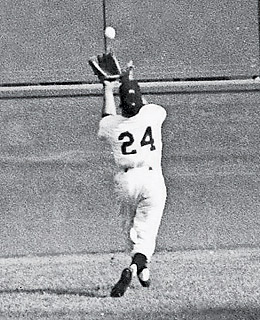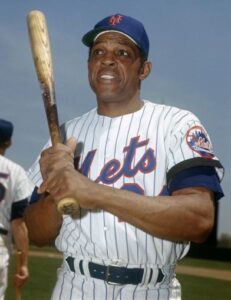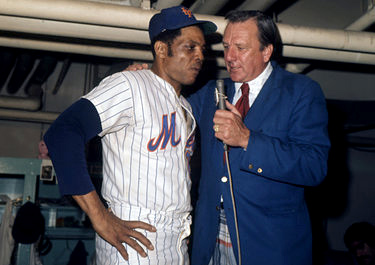As we all know, the Mets were created fill the gap left after the departure of the Giants and the Dodgers from the city of New York following the 1957 season. In the four year period before the advent of the Amazin’s, Gotham’s National League fans were left to follow their teams as best they could from afar (remember, no cable TV at this time nor webcasts, and radio coverage was spotty at best if you were following a west coast team).

For die-hard fans, and there were many, this was a hardship that was duly noted by the fledgling Met ownership which sought to assuage (or exploit, depending on how you look at it) their feelings of abandonment by bringing in notable Dodger greats like Gil Hodges and Duke Snider for a last go-round in a Met uniform.
But for fans of the “New York baseball Giants” as they were once referred to, there were no remaining links to the glory days of the team. Instead, they were left to scan the box scores or change their allegiance to the Yankees. The latter choice was anathema to most of the Giant faithful, including my father, who had regaled me with stories of following the 1951 pennant race by radio as many had done, and had exulted with much of the city as Bobby Thomson’s “Shot Heard Round the World” was broadcast. His favorite player was not Thomson, however. It was the Giants’ wunderkind, Willie Mays.
Mays had a place in New York baseball folklore as part of a triumvirate of great center fielders along with Mickey Mantle and the Duke, but had a penchant for near-mythical displays that seemed to supersede his contemporaries. Who could forget “The Catch” where he tracked down Vic Wertz’ missile in the 1948 World Series or “The Throw” where he ran to catch a shot in the right field gap and spun on the dead run to unleash a throw like no one had ever seen to catch the Dodgers’ Billy Cox at the plate? Not to mention an MVP season in 1954 and a 1955 season where he clubbed 51 homers, a feat that was downright uncommon in the pre-steroid era.
 Mays would go on to more glory with the Giants, including a pennant in 1962, another MVP in 1965, Gold Gloves, perennial All Star appearances, and all the things that fans bask in when their team and their favorite player are in the limelight. But Mays was San Francisco’s now, even if those fans more readily embraced Willie McCovey. New York fans were left with their memories…and the Mets.
Mays would go on to more glory with the Giants, including a pennant in 1962, another MVP in 1965, Gold Gloves, perennial All Star appearances, and all the things that fans bask in when their team and their favorite player are in the limelight. But Mays was San Francisco’s now, even if those fans more readily embraced Willie McCovey. New York fans were left with their memories…and the Mets.
So, when the buzz began in May of 1972 that a deal was in the works to bring Willie back to the east coast, the “sleeping Giant” so to speak, of 1950’s New York baseball fandom began to stir. And lo, so it was, for a mere $50,000 and a middling right-hander named Charlie Williams, the Mets finally obtained what may have been the most symbolic link to the city’s baseball legacy. And, largely symbolic it was, because at 41 years of age, Mays was clearly a shadow of his former self as a player. Still, his mere presence in a Met uniform was enough to drive fans into a state of excitement usually reserved for visits from the President or the Pope.
Fans flocked to Shea for the series against Mays’ now former employers the Giants. Willie was set to make his debut as a Met in the Sunday game on May 14th, but when the team needed a pinch hitter in the Friday game prior, fans began clamoring for manager Yogi Berra to send him to the plate. When John Milner emerged from the dugout instead, he was booed roundly “for not being Willie Mays” as I recall the announcer Lindsey Nelson reporting. Finally, the big day arrived and Mays was in the lineup, leading off and playing center field.
 My dad and I watched the game together. He had been a fairly hard core NY Giants fan but had come over to the Met side of the dugout for the most part as his kids had “caught baseball fever” as a MLB marketing campaign had urged and gotten swept up in the championship run of 1969. But today was all about number 24 and his return to the fold.
My dad and I watched the game together. He had been a fairly hard core NY Giants fan but had come over to the Met side of the dugout for the most part as his kids had “caught baseball fever” as a MLB marketing campaign had urged and gotten swept up in the championship run of 1969. But today was all about number 24 and his return to the fold.
If you are familiar with the game, you know that it began auspiciously for the Mets, with Giants pitcher Sam McDowell walking the bases full and then surrendering a grand slam to Rusty Staub. By the bottom of the fifth however, the Giants had tied the score and McDowell had been lifted in favor of right hander Don Carrithers. Mays led off the inning and unloaded on a fastball. As the ball cleared the fence in left and Mays trotted around the bases for the 647th time in his career, my father stopped grinning long enough to tell me “That’s the way it should be.” Cornball, but I swear it’s a true story.
That homer provided the winning edge as the Mets prevailed 5-4, and even though moments like that would be few and far between for the balance of Mays’ Mets career, the memory of that triumphant return and its near-poetic climax (hitting the homer in the bottom of the ninth would have clinched the poetic part, but let’s not squabble over details) remains indelible. The Mets and Mays had helped the New York branch of Giant fans to reclaim at least part of their legacy and gave the team that abandoned them a swat in the process. For that day, it was enough.
















